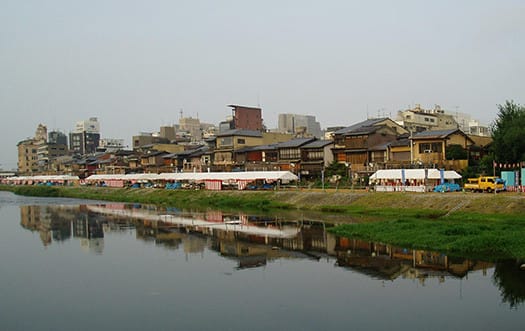


写真は京都の先斗町を賀茂川越に見たものと、栃木県足利市の古建築景観。
江戸期までの日本社会は基本的には農業立国・海民的暮らしを支える生産構造としてのムラ社会と、都市では農家の次男三男たちが流民となって長屋などに集住し、それとは別に商家という生き方を選択した階層が存在していた。そのほかでは武家がいたけれど、かれらの住居は非生産的な佇まいであり、生活感というものがきわめて希薄だったと思う。
基本的にムラというきわめて帰属性の強い結びつきが最上位に存在したのだと思う。イエ・住宅というものは、土間という作業空間を取り込んだ職住一体であり、それら家同士の相互扶助、相互責任関係の中で、ムラ社会はいわば「まゆ」のように人びとを包み込んでいたものだった。
個人主義よりも、ムラ社会の共同性のほうがはるかに優越して存在していた。
その社会倫理感・生活感が主流の価値感であって、都市居住者も基本的にそのムラ社会的な意識が支配的倫理として受容していたのだと思われる。たぶん幕府という政治機構自体がそういう社会基盤を無意識的に踏襲して存在していたのだろう。
ひとびとが生きていく、暮らしていくということは当然、ムラ的共同体と一体的意識のなかにあった。家系というものもムラ社会のなかでの位置付けが強固に存在していた。
わが家の家系が北海道に移住してきたときも、このムラ社会の一員が先行して移住し一定の成功を収めていたことに誘われ、導かれていた。強固なムラ価値感。
最近は少しは薄れつつあるとは言え、盆暮れという長期休暇ごとに繰り返される「里帰り」という日本人的営為には、この事実が刷り込まれているのだと思う。
こういう人間意識は、明治以降、さまざまな産業勃興があって、都市にひとびとを集中させていく流れの中でも、根強く存在し続けていたのだと思う。
それが「都市居住」のなかでも立地選択というときに強く作用する、なんらかの「選択基準」として機能したのではないかと思っている。
今日の拡大した都市での「街区選択」ということのなかにその残滓が見られる。
住宅建築・購入時、いくつかの選択可能な街区選びの時に「なんとなく」惹かれていくことにはこういうポイントがきわめて大きいだろう。
本人は住宅性能の専門家であり研究者である立場でありながら、自宅は相当隙間面積3㎠/㎡を超える低気密住宅を選択したという方と話したけれど、どうしても奥さんが「住みたい」と希望したのは札幌の「高級住宅地」に建つこの低性能建売住宅で、押し切られたのだという。
住宅性能という意味合いからは劣悪だけれど、しかし社会的価値感としては理解することはできる。その街区の放っている空気感のようなもの、都市の中での「街区選択」行為の基準としても、長く民族意識に刷り込まれている地域(ムラ)への共生感意識をが刺激される部分があるのだろう。その一員として生きていたいという欲求。
そして人間の生きる「環境」選択のなかで、この要素は非常に大きいことが理解できるのだ。
English version⬇
[Modern People's Way of Life Choices: Mura and Choosing a Comfortable Living Environment-2
An example of a housing performance researcher who chooses a low airtight house with an equivalent clearance area of more than 3c㎡. The selection of town block projects the mura-like sense of community value of the Japanese people. ...
The photo shows Pontocho in Kyoto as seen over the Kamo River and the ancient architectural landscape of Ashikaga City, Tochigi Prefecture.
Until the Edo period, Japanese society was basically an agricultural nation, with the mura (village) society as a production structure that supported a seafaring lifestyle, and the second and third sons of farmers in the cities who became exiles and lived in tenements and other places. In addition, there were samurai families, but their dwellings were unproductive and their sense of life was extremely limited.
Basically, I believe that a strong sense of belonging, the mura (village), existed at the top of the hierarchy. Houses and residences were a single unit of work and residence, incorporating a working space called an earthen floor, and in the relationship of mutual support and responsibility among these houses, the mura society enveloped the people like a cocoon.
The communal nature of mura society was far superior to individualism.
This sense of social ethics and lifestyle was the prevailing sense of values, and it seems that city dwellers basically accepted this mura social consciousness as the dominant ethic. Perhaps the political structure of the shogunate itself unconsciously followed such a social foundation.
People's lives and livelihoods were naturally integrated with the mura community. The family lineage was also firmly positioned within the mura community.
When my family immigrated to Hokkaido, it was guided by the fact that members of the mura community had already immigrated there before us and had achieved a certain level of success. A strong sense of mura values.
Although it is fading a little these days, I believe that this fact is imprinted in the Japanese practice of "sato-kitari," which is repeated every long vacation season, Bon and year-end.
I believe that this kind of human consciousness has continued to persist even in the midst of the concentration of people in the cities since the Meiji era, with the emergence of various industries.
I believe that this human consciousness functioned as some kind of "selection criterion" that had a strong effect on the choice of location in "urban residence".
We can see remnants of this in today's expanded urban "choice" of neighborhoods.
When building or purchasing a house, one may be attracted to a certain neighborhood "somehow" when choosing one of several available neighborhoods.
I spoke with a person who is a housing performance expert and researcher, but who chose a low airtight house with an equivalent clearance area of over 3 square meters for his home, but his wife insisted that she wanted to live in this low-performance house for sale in a "high-end residential area" in Sapporo, and she was pushed into it.
Although the house is inferior in terms of housing performance, it is understandable in terms of social values. The atmosphere of the neighborhood and the "choice of neighborhood" within the city may also stimulate a sense of symbiosis with the local community (mura), which has long been imprinted in the consciousness of the local people. The desire to live as a member of the community.
And we can understand that this factor plays a very important role in the choice of "environment" in which people live.



















